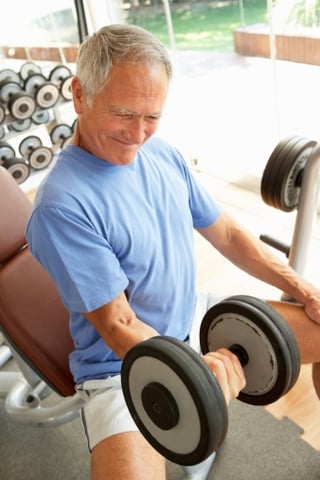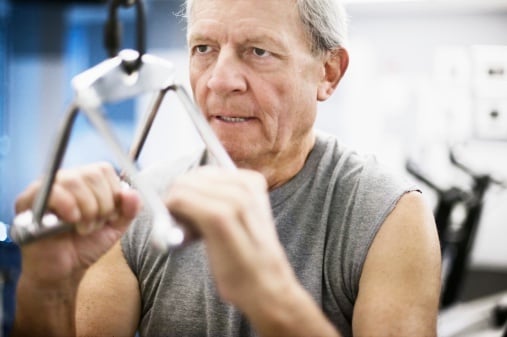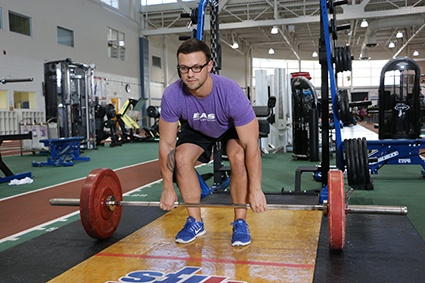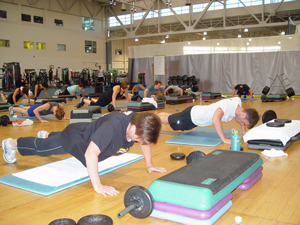 This is the final installment in my series on training for people 40 and over. Previously I’ve discussed training needs and health concerns for older adults, the importance of strength training, and the role of the glutes. Now let’s talk about the old-school way to reach your fitness goals while aging gracefully.
This is the final installment in my series on training for people 40 and over. Previously I’ve discussed training needs and health concerns for older adults, the importance of strength training, and the role of the glutes. Now let’s talk about the old-school way to reach your fitness goals while aging gracefully.
Someone on Facebook said she wanted to train her back harder than her grip would allow and asked which would be better, lifting straps or Versa Gripps. The answers bounced back and forth between the two options (usually bodybuilders doing the commenting), but I just had to offer a third option: neither.
“Old school–develop your grip strength so it’s not the weak link.”
Some of the clueless responses from a few bodybuilders about grip work interfering with arm and back day and how you couldn’t develop your back if you had to wait for your grip were sadly amusing.
Shortcuts Don’t Pay
If she did use the straps or Versa Gripps to allow for heavier loading of the back for the sake of back development (aesthetics), the grip would continue to be weaker than the muscles up the movement chain and would therefore be a rate limiter in the upper body’s functional strength. This imbalance could be a source of future injuries as well. And of course, this begs the question: why is there an imbalance in the first place?
When the focus of fitness is to look better in front of a mirror, concepts like correcting movement deficiencies, addressing strength weaknesses, and the effects of rate limiters on functional strength have as much interest as broccoli does to a 3-year-old.
It’s easy to pick on bodybuilding because to those on the outside, bodybuilding seems to be the extreme example of narcissistic frivolousness. But alas, all exercise and fitness pursuits have a huge egocentric component, whether it’s picking up more weight, running faster/further, or killing Fran or Fight Gone Bad.
Sometimes You Just Have to Eat Your Broccoli
The point is that we are all results-driven regardless of whether our fitness interests are functional training or just looking better. We want improvements to arrive quicker and the process to be easier, even if the shortcuts we take for short-term gains have a high price on the back end. Seemingly innocent lifting straps are at one end of the shortcut continuum, and PEDs at the other; but they all are attempts to circumvent the body’s natural processes. All the things you chose to ignore, neglect, and ill-advised shortcuts will eventually show up during your fitness “come to Jesus meeting” sometime in your 40s and 50s. And just know that the accompanying injuries that come during that meeting are served in a broccoli casserole, heavily seasoned with “I Told You So.”
Take shortcuts and ignore weakness at your own peril. There, I just told you so. Go eat your broccoli!
Learn more about your current fitness status with NIFS’s Functional Movement Screening or Personal Fitness Evaluation.
This blog was written by Rick Huse, CSCS, WKC Competition Coach. To find out more about the NIFS bloggers, click here.


 For many in this age group, other medical conditions seem to appear from out of nowhere. Theories for why range from genetics to reduction of stem cells, but the fact remains: unexpected conditions and diseases show up uninvited and certainly unwanted from about 45 and beyond. If you are in this age group and actively training, you need to know a lot more about your body, especially your age-related limitations.
For many in this age group, other medical conditions seem to appear from out of nowhere. Theories for why range from genetics to reduction of stem cells, but the fact remains: unexpected conditions and diseases show up uninvited and certainly unwanted from about 45 and beyond. If you are in this age group and actively training, you need to know a lot more about your body, especially your age-related limitations.  At times you may hear somebody at the gym or fitness center saying, “I don’t want to look like a bodybuilder,” or “I don’t want to be a powerlifter.” That’s great! That person knows their goals and also what they want to avoid. However, don’t let your specific goals cause you to have myth-generated fears of certain exercises.
At times you may hear somebody at the gym or fitness center saying, “I don’t want to look like a bodybuilder,” or “I don’t want to be a powerlifter.” That’s great! That person knows their goals and also what they want to avoid. However, don’t let your specific goals cause you to have myth-generated fears of certain exercises.  In
In  The concept of defining fitness seems simple at first glance, but like Jell-O®, the definition of fitness appears solid on the surface until you grab at it and realize that impression was wrong. Both will get messy while they ooze in all directions.
The concept of defining fitness seems simple at first glance, but like Jell-O®, the definition of fitness appears solid on the surface until you grab at it and realize that impression was wrong. Both will get messy while they ooze in all directions.







 move pretty well at one test, it will eventually find a restriction or asymmetry/imbalance at some point if you have any. Our job is to identify any weaknesses, limitations, imbalances, or asymmetries so that we can immediately prescribe you a corrective strategy to reduce your chance for injury and increase fitness results.
move pretty well at one test, it will eventually find a restriction or asymmetry/imbalance at some point if you have any. Our job is to identify any weaknesses, limitations, imbalances, or asymmetries so that we can immediately prescribe you a corrective strategy to reduce your chance for injury and increase fitness results.